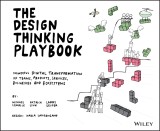Details

The Design Thinking Playbook
Mindful Digital Transformation of Teams, Products, Services, Businesses and EcosystemsDesign Thinking Series 1. Aufl.
|
25,99 € |
|
| Verlag: | Wiley |
| Format: | |
| Veröffentl.: | 24.04.2018 |
| ISBN/EAN: | 9781119467489 |
| Sprache: | englisch |
| Anzahl Seiten: | 352 |
DRM-geschütztes eBook, Sie benötigen z.B. Adobe Digital Editions und eine Adobe ID zum Lesen.
Beschreibungen
<p><b>A radical shift in perspective to transform your organization to become more innovative</b></p> <p><i>The Design Thinking Playbook</i> is an actionable guide to the future of business. By stepping back and questioning the current mindset, the faults of the status quo stand out in stark relief—and this guide gives you the tools and frameworks you need to kick off a digital transformation. Design Thinking is about approaching things differently with a strong user orientation and fast iterations with multidisciplinary teams to solve wicked problems. It is equally applicable to (re-)design products, services, processes, business models, and ecosystems. It inspires radical innovation as a matter of course, and ignites capabilities beyond mere potential. Unmatched as a source of competitive advantage, Design Thinking is the driving force behind those who will lead industries through transformations and evolutions.</p> <p>This book describes how Design Thinking is applied across a variety of industries, enriched with other proven approaches as well as the necessary tools, and the knowledge to use them effectively. Packed with solutions for common challenges including digital transformation, this practical, highly visual discussion shows you how Design Thinking fits into agile methods within management, innovation, and startups.</p> <ul> <li>Explore the digitized future using new design criteria to create real value for the user</li> <li>Foster radical innovation through an inspiring framework for action</li> <li>Gather the right people to build highly-motivated teams</li> <li>Apply Design Thinking, Systems Thinking, Big Data Analytics, and Lean Start-up using new tools and a fresh new perspective</li> <li>Create Minimum Viable Ecosystems (MVEs) for digital processes and services which becomes for example essential in building Blockchain applications</li> </ul> <p>Practical frameworks, real-world solutions, and radical innovation wrapped in a whole new outlook give you the power to mindfully lead to new heights. From systems and operations to people, projects, culture, digitalization, and beyond, this invaluable mind shift paves the way for organizations—and individuals—to do great things. When you're ready to give your organization a big step forward, <i>The Design Thinking Playbook</i> is your practical guide to a more innovative future. </p>
<p>Foreword 7</p> <p>Introduction 10</p> <p><b>1 Understand Design Thinking 13</b></p> <p>1.1 What needs are addressed in the Playbook? 14</p> <p>1.2 Why is process awareness key? 36</p> <p>1.3 How to get a good problem statement 50</p> <p>1.4 How to discover user needs 58</p> <p>1.5 How to build empathy with the user 72</p> <p>1.6 How to find the right focus 80</p> <p>1.7 How to generate ideas 90</p> <p>1.8 How to structure and select ideas 98</p> <p>1.9 How to create a good prototype 108</p> <p>1.10 How to test efficiently 118</p> <p><b>2 Transform Organizations 131</b></p> <p>2.1 How to design a creative space and environment 132</p> <p>2.2 What are the benefits of interdisciplinary teams? 144</p> <p>2.3 How to visualize ideas and stories 158</p> <p>2.4 How to design a good story 168</p> <p>2.5 How to trigger change as a facilitator 180</p> <p>2.6 How to prepare the organization for a new mindset 190</p> <p>2.7 Why strategic foresight becomes a key capability 198</p> <p><b>3 Design the Future 211</b></p> <p>3.1 Why systems thinking helps to understand complexity 212</p> <p>3.2 How to apply lean business model thinking 224</p> <p>3.3 Why business ecosystem design becomes the ultimate lever 240</p> <p>3.4 How to bring it home 254</p> <p>3.5 Why some design criteria will change in the digital paradigm 266</p> <p>3.6 How to kick-start digital transformation 278</p> <p>3.7 How artificial intelligence creates a personalized customer experience 292</p> <p>3.8 How to combine design thinking and data analytics to spur agility 302</p> <p>Closing words 314</p> <p>Authors 323</p> <p>Sources 335</p> <p>Index 338</p>
<p><b>Michael Lewrick,</b> PhD, is an international speaker and teaches design thinking as a visiting professor at various universities, and author of <i>Design Thinking: Radical Innovations in a Digitized World</i></p> <p><b>Patrick Link,</b> PhD, is Professor of Product Innovation and Chair of Industrial Engineering at Lucerne University of Applied Sciences in Switzerland. He is intensively involved in the development of agile methods in product management, design thinking and lean start-ups.</p> <p><b>Larry Leifer,</b> PhD, is one of the founders of Design Thinking, and teaches in the d.school at Stanford University, where he is Professor of Mechanical Engineering Design. He is the Founding Director of the Hasso Plattner Design Thinking Research Program at Stanford.</p>
<p><b>"This book is THE best definition of Design Thinking that I have seen."<br> </b>— Kees Dorst, author of <i>Frame Innovation</i> <p><b>"The Design Thinking Playbook not only outlines and describes how to apply design thinking. (…) This is an imaginative new contribution."<br> </b>— Nigel Cross, author of <i>Design Thinking: Understanding how designers think and work</i> <p><b>"Worthwhile because of the authors, the structure and the contents. (…) </b><b>Despite the playful presentation, the team succeeded to work out a surprisingly profound book."<br> </b>— <i>Harvard Business Manager</i> <p><i>The Design Thinking Playbook</i> will help individuals, teams, and organizations: <ul> <li>Apply design thinking tools and methods in the right context—especially to digital products and services</li> <li>Understand the latest advances in design thinking coming out of Stanford's d.school</li> <li>Build awareness for user-centricity</li> <li>Apply design thinking to the challenges of digital transformation in organizations</li> <li>Combine Design Thinking with Systems Thinking and Big Data Analytics</li> </ul>

















